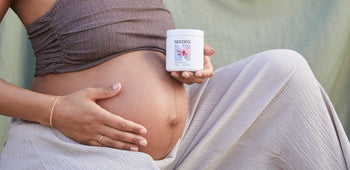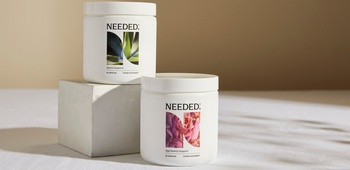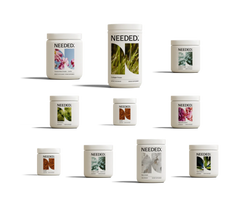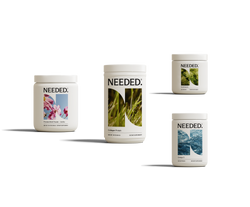Intro
Trying to conceive can be an exciting time, but when it doesn’t result in a pregnancy right away it can quickly become stressful. And once you start to dig into the information out there on fertility it can easily become overwhelming.
So we’re breaking it down. Where do you start and what steps do you need to take to prepare for conception and a healthy pregnancy? And what do you need to understand about how your body and your partner’s body work in order to increase the likelihood of conception?
Before we dive in, let’s start with the basics. For conception to occur, you need four things:
-
Sperm
-
An egg
-
Fertilization (when sperm meets egg)
-
A healthy environment for the fertile egg to implant and grow
While this seems pretty simple, fertility is complex and things don’t always happen as expected. However, working through these steps can help you understand where there may be a disconnect so that you can detect issues early on that would prevent you from conceiving later.
Step 1: Start taking a prenatal
First things first, if you decide to actively start trying to get pregnant, you need to start pretending you already are. And the first step in that process is to start taking a prenatal vitamin. Why already? Because a baby demands tremendous nutrition from the moment that sperm meets egg. And since we don’t find out that we are pregnant until 2-3 weeks after this happens, not taking a prenatal vitamin from the start can impact baby’s health before you even know that baby exists! And it can disrupt #1 and #4 above - the egg and the healthy environment that the egg needs to implant and grow.
In addition, a high quality prenatal can help you start to address nutrient deficiencies before pregnancy that can help support fertility, help manage morning sickness and fatigue, and contribute to a healthier pregnancy for both you and baby. While we do always recommend a balanced diet, the reality is, when it comes to growing another life, food simply isn’t enough.
But not all prenatals are created equal. The vast majority on the market have amounts or forms (or both!) of nutrients that fail to meet your needs. Some forms of nutrients are far better absorbed than others, but nutrition companies still favor the cheaper, less well-absorbed forms to boost their bottom lines. Other nutrients, like Choline, are left out or included in woefully inadequate amounts, as they are simply too bulky to include in the amounts you actually need. A quick test: if your prenatal only requires 2 pills per day, it probably isn’t cutting it. Two pills is simply not enough space to contain all of the nutrients needed to support a growing baby and his or her mama. If you’re curious what yours should contain, check out our comprehensive guide: What to Look for in a Prenatal.
In addition to a prenatal vitamin, we recommend taking a probiotic that is targeted to pregnancy as well as an Omega-3 supplement, both of which are critical to a healthy pregnancy and contribute to fertility outcomes as well. We also recommend ensuring adequate protein for blood sugar management, hormone balance, and growing baby's cells and the placenta. This is why we’ve included Collagen Protein in our Prenatal Plan - it is in an optimal form for all of these important tasks.
You may also consider nutrient testing, particularly for nutrients that are frequently deficient in many women and can impact fertility, like Vitamin D and Omega-3s.
Step 2: Evaluate your lifestyle and toxin exposure
Another step in acting like you are already pregnant is to remove as many toxins from your life as possible. We will always be exposed to a certain amount of toxic substances - certain things like air pollution can be unavoidable. But controlling the things you can control can greatly benefit you and baby from preconception to postpartum and beyond.
Toxins can include endocrine disruptors in our cleaning and personal care products that impact hormones. They can also include substances like alcohol and caffeine. While these are present in many of our lives, they require extra work for our bodies to eliminate and only work against you when it comes to your health and ability to support a growing baby.
For an in-depth guide on how to identify and eliminate toxins in your life, check out our three-part series on preparing for conception with a pregnancy-safe detox.
Step 3: Figure out when you are fertile
To support the chances of #3 above sperm meeting egg, it’s necessary to know when you are fertile. Knowing your fertile window, or the period of time around ovulation, gives you the information you need to time intercourse correctly. There are several options to track ovulation:
- Luteinizing hormone (LH tests): also known as ovulation predictor kits, these inexpensive at home test strips work similar to a pregnancy test. Your urine will indicate a surge in LH hormone by showing 2 dark lines just before ovulation is about to occur.
- Cervical mucus monitoring: your cervical mucus changes throughout your cycle. It increases in volume and becomes a different “egg white” like texture in preparation for conception. This fluid is a key component of #3 above - it helps guide sperm to egg so that the egg can be fertilized. While you can try to monitor this on your own, it can be pretty elusive. Companies like Kegg can take the guesswork out and provide precise monitoring of your fluid.
- Basal body temperature (BBT) monitoring: just as your cervical fluid changes throughout your cycle, so does your basal body temperature. Your BBT is the lowest body temperature attained during rest, usually estimated by a temperature measurement immediately after waking, before even getting out of bed. It dips a bit just before your ovary releases an egg. Then 24 hours after the egg's release, it rises again and stays up for several days. You can leave a thermometer by your bed to take your temperature first thing (and remember to log it in your phone or on a piece of paper). Or you can use a health tracking device like the Oura Ring to simplify the process.
With these methods, you will know which days are your most fertile so you can time intercourse correctly and have the best chance at conception.
Step 4: Optimize your chances by confirming successful ovulation
You may be tracking the signs of ovulation, but while your body may show signs ovulation is coming, it doesn’t always occur! And without ovulation, you have no chance of conception. Additionally, not all ovulation is created equal - some ovulatory events give you a better chance at conception than others. This is why confirming successful ovulation is key from the start of your TTC journey.
Ovulation is considered successful when an egg is released and the empty follicle produces enough progesterone over time to support implantation, should an egg become fertilized. While doctors can order progesterone tests, they only show levels at one point in time, which can be an issue as progesterone needs to remain elevated for several days in order to allow for the best possible chance at conception.
Luckily, there is an easier way to confirm successful ovulation at home! Proov PdG tests are the first and only FDA cleared PdG tests to confirm successful ovulation. PdG is a urine metabolite of progesterone and only rises when serum progesterone levels are also elevated. Unlike a one-time progesterone blood draw, with Proov you can test PdG levels over a period of 4 days after peak fertility, which is a critical window when it comes to confirming successful ovulation.
If your Proov PdG results are positive days 7-10 after peak fertility , then ovulation is considered successful and you can move onto the next step. Ovulation is also successful if you get three positive PdG tests, as long as you get a positive on day 10 past peak fertility. However, if 2 or more of your Proov PdG tests are negative during the testing window, there are a few changes you can make to help increase PdG and improve ovulation quality:
Improving Ovulation Naturally
- Diet: While foods don’t directly contain PdG, there are some foods which can help improve PdG production like beans, broccoli, pumpkin, or spinach.
- Seed Cycling: Seed cycling involves eating different types of seeds during different phases of your cycle. The seeds help promote a hormone balance in your body. You can learn more about seed cycling on Proov's site.
- Herbals: Herbs like vitex, red raspberry leaf, and maca can all help PdG production and promote a hormone balance.
- Supplementation: Bio-identical progesterone supplements are widely available but must be prescribed by a doctor.
After making one or more of these changes for a cycle, you can retest your ovulation quality. If your results improve, then great! Ovulation is likely no longer preventing you from conceiving and you can move on to Step 5.
If you’ve tried to improve ovulation and still aren’t seeing positive ovulation results, we recommend additional testing with your doctor. They may recommend other hormone tests like AMH for egg count, FSH and LH for ovary function, and TSH for thyroid function.
Step 5: Check out his swimmers
Once you’ve got the fertile window and healthy ovulation covered, it’s important to understand what’s going on with your partner’s sperm. There are two main aspects of sperm that matter most: sperm count and sperm motility, meaning are there enough sperm in ejaculate and they can get to where they need to be (the egg).
While some doctors may test sperm, it is often a later step in the infertility process. There are many at-home sperm tests on the market that test sperm count but only a few that test count and motility, so look for a kit that measures both. If your partner’s sperm test results show he’s all good, then great! You can check this box and move on. If the sperm test shows low sperm count or motility, there are a few things you can do to try on your own:
- Diet or lifestyle changes: One suggestion for improving sperm is changing his diet or lifestyle. Check out our list of the top 10 foods to eat and avoid here! In addition to these, reducing stress, ensuring adequate sleep, limiting environmental toxins (as discussed in Step 2 above), and incorporating regular exercise can support healthy sperm.
- Supplements: Supplements like maca root or tribulus terrestris have both been shown to improve sperm count in men. Of course, make sure your partner clears these supplements with his provider first. We also like ensuring that partners are meeting all of their nutrient needs, and often find that men can benefit from a comprehensive prenatal and Omega-3 supplement as well.
- Sperm friendly lubricant: Make sure to check that your lubricant is “sperm friendly.” Many lubricants contain ingredients or have a pH that can be harmful to sperm. Sperm friendly lubricants also mimic the viscosity and consistency of cervical mucus, making it an ideal environment for the sperm to travel.
- Try boxers: Does your partner wear tight underwear? Research has shown that tight underwear may impair sperm production. Boxers fit more loosely and are preferred if you’re concerned about sperm.
After making any or all of these changes, have your partner retest his sperm. If his results don’t improve, we recommend consulting his doctor for further testing and investigation.
If you’ve made your way through these five steps and still have not had a positive pregnancy test, we recommend reaching out to your providers and sharing with them the steps you’ve taken thus far. They can test you for less common causes of infertility like blocked fallopian tubes, genetic factors, or structural abnormalities within the uterus.
However, starting with this checklist and some at-home options can help save you both time and money on your conception journey and can help you detect any issues that may prevent you from successfully conceiving sooner!
This list also aims to empower you to have more educated and productive conversations with your provider. Because the more you know about your fertility, the more effectively you can use your time with a doctor (and your money!) to help you reach your goals faster.











